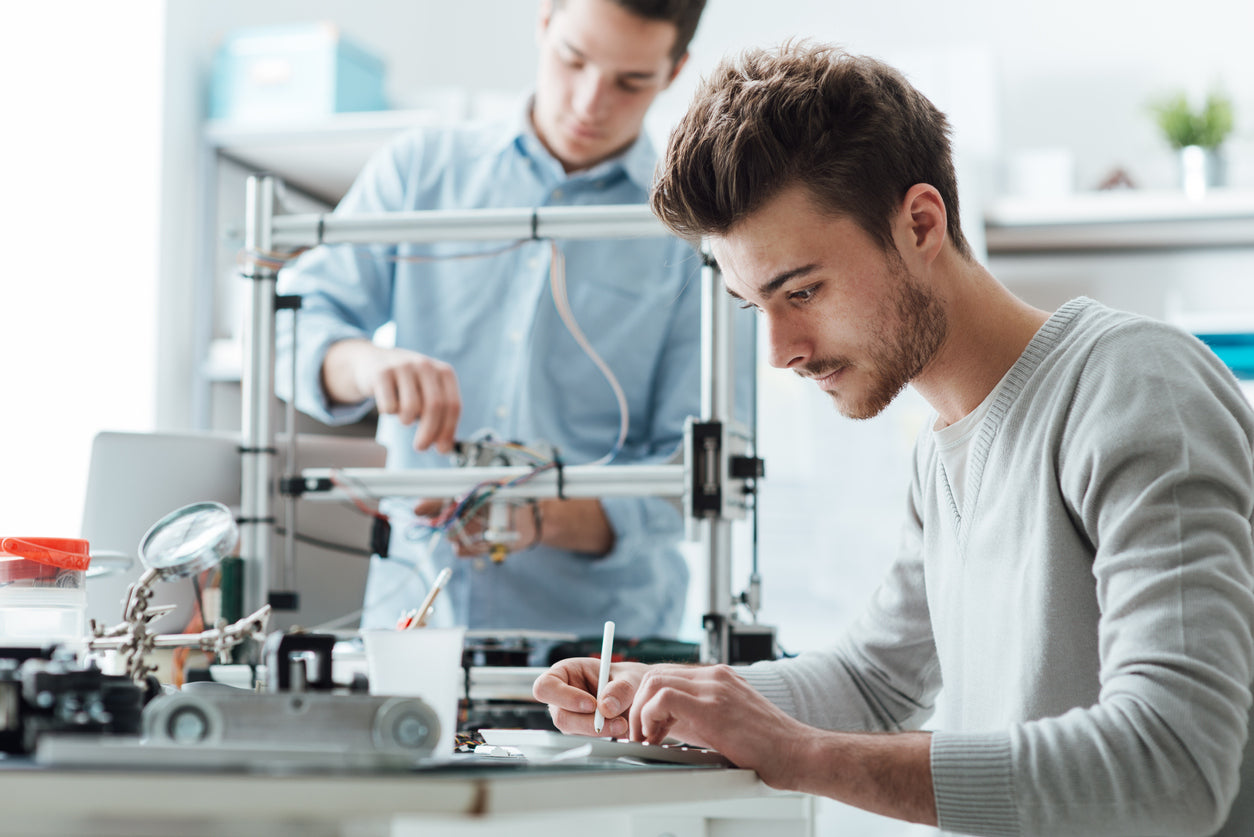3D printing holds incredible potential for manufacturing. As the technology matures and prices come down, it is now possible to have 3D printers in our home workshops and school classrooms, allowing for more people to get involved in 3D printing as a hobby or even a business.
Unfortunately 3D printers might also negatively affect your indoor air quality because of the fumes and other pollutants they emit. To learn what air purifier is the best to counter the effect of 3D printers, we will examine the pollutants that printers give off and which devices are well-suited for removing those pollutants from the air.
In an industrial setting, filters and powerful ventilation systems are often in place to maintain proper indoor air quality, which can be measured against workplace standards set by the government. However, none of these are in place for home or school users of 3D printers. Because this technology is relatively new, regulations scarcely exist at all, and no one is conducting inspections of your home workshop to make sure your 3D printer’s emissions meet OSHA standards. This means it is up to you to keep your indoor air quality safe and healthy. One way to do this is to use an air purifier.
Do air purifiers work for 3D printer fumes and particulates?
3D printers utilize a variety of methods to produce three-dimensional shapes, but most commercially sold 3D printers for individuals or smaller organizations use a method called molten polymer deposition (MPD). This process is also called fused deposition modeling (FDM). MPD printers extrude plastic through a nozzle, melting plastics at temperatures up to 320°C and depositing it in thin layers that are built up to form the desired object. When plastics are heated to such high temperatures, its components begin to degrade and are released into the air as very fine pollutants and fumes. An air purifier should be capable of reducing these types of pollutants in the air.
We will focus on MPD 3D printing here. The popular MakerBot printers fall into this category. Other types of 3D printers will likely produce different types of pollutants, but almost all of them rely on powders, binding agents or melting of base materials, so air purification systems should be a consideration regardless of the specific type of printer you use.
Types of 3D printer pollutants
Because they are so common, most laboratory tests have been conducted on MPD 3D printers. These printers produce two types of pollutants: Volatile organic compounds (VOCs) and ultrafine particles (UFPs).
Plastic fumes (VOCs)
The plastic used in 3D printers is typically either acrylonitrile butadiene styrene (ABS) or polylactic acid (PLA). Both plastics give off a range of VOCs when heated to such high temperatures, including styrene, formaldehyde, methyl methacrylate and hydrogen cyanide. Carbon monoxide may also be produced. The right air purifier technology would have to address VOCs, and not all of them do. Traditional air filters like HEPA filters or ionizers are only designed for particles, not gases, making them ineffective against the harmful concoction of VOCs that are emitted during the 3D printing process.
ABS plastic is potentially more harmful because it melts at a higher temperature than PLA, and a higher melting point tends to cause the release of more toxic compounds (Stephens et al., 2013). We know that melting plastic fumes are toxic to rats, mice and other mammals (Schaper, Thompson & Detwiler-Okabayashi, 1994). Furthermore, many 3D printer base materials have additives included, to add color, flexibility, electrical conductivity or other attributes. These additives may be adding still more toxic VOCs to the air when heated.
Plastics and ultrafine particles
Ultrafine particles (UFP) are another area of concern that come from heating plastics at such high temperatures. Like VOCs, these particles are a byproduct of the melted materials from the feedstock. These particles can be smaller than 0.1 micrometers in diameter, which can easily be inhaled deep into the lungs and even enter the bloodstream. Testing on rats revealed immediate, short-term effects on blood pressure and cardiovascular health (Pelley, 2018). The long-term effects of UFP inhalation from 3D printers are poorly understood at the moment, but it is probably a fair bet that UFP accumulation in the lungs is not good for you. Because of their miniscule size, existing air filters would need to have special technology to take care of these kinds of pollutants. Traditional air filters can usually take care of particles of a certain size (they often promise to be most efficient for particles that are 0.3 micrometers wide), but the size of UFP are often smaller than this.
These two types of pollutants make 3D printers an especially tricky problem for air purifiers, because the purifier needs to be able to deal with two very different types of pollutants: VOCs and UFPs.
What type of air purifier is best for 3D printer pollution?
Each air purification technology has its own strengths and weaknesses, and not all air purifiers can handle both particulate pollutants and VOCs.
HEPA – HEPA filters are designed to a specific standard to remove 99.97 percent of particles of 0.3 microns in size. Because UFPs from 3D printers may be as small as 0.1 microns in size, a HEPA filter will be unable to remove all of them from the air. But these tiny particles tend to cling together or to other particles in the air, increasing their size. And studies have found that enclosing the printer itself in a HEPA filtered enclosure reduced UFP concentrations in the room by 98 percent. So a HEPA filter can help reduce the amount of UFPs in the room, even if it cannot remove every single one. However, HEPA filters do not remove VOCs or burning plastic odors.
Carbon filters – Carbon filters use activated charcoal to remove VOCs from the air. The carbon contains numerous spaces where VOC molecules can become attached, like a lock fitting into a keyhole. This process, known as “adsorption,” can effectively remove VOCs as well as odors from the air. The problem with carbon air purifiers is that they gradually lose their efficiency as the carbon “fills up” with VOC molecules. Eventually, the filter will not only stop working, but also begin emitting those same toxic compounds back into the air. Therefore, they need to be replaced frequently. Moreover, carbon filters cannot filter certain compounds, like carbon monoxide and other types of gases. Because the VOCs emitted by 3D printers are related to melting plastic, household carbon filters may not be as effective at removing them. Finally, carbon filters do not capture any particulate pollutants, including UFPs, whatsoever.
Ozone generators – Ozone generators not only have a limited effectiveness of removing gases, but they also produce harmful ozone, which is a lung irritant. Toxic byproducts are also created during this process, adding to the airborne chemicals already in the air because of hot plastic in the printer. Moreover, ozone generators do not eliminate particles, so the potentially dangerous UFPs are unaffected. Because of these factors, the EPA does not recommend ozone generators for use in enclosed spaces.
Ionizers – Ionizers apply an electric charge to particles that pass through it, causing them to clump together and settle out of the air. But this process produces ozone, which means they have the same drawbacks as ozone generators. Ionizers are also ineffective against VOCs, so they will not remove the toxic by-products of melting plastic produced by 3D printers. Some air purifiers have a special “ionizing” section to complement the primary technology contained in the device.
PCO – PCO air purifiers claim they can remove VOCs from the air using a photochemical reaction. However, the by-products of these reactions are unpredictable and may be toxic. In addition, PCO air purifiers emit some ozone, and they are not effective against particulate pollutants.
Our recommendations for 3D printing pollutants
PECO air purifier – The Molekule PECO air purifier is an ideal solution for 3D printers because it removes both particles and VOCs from the air. The toxic fumes from 3D printers are permanently destroyed, so they are not released back into the air, as in the case of a carbon filter, where VOCs are temporarily trapped on a surface and can potentially “unstick” from the filter if conditions change. What is also unique to PECO technology is that it can destroy 3D printer particulates that are carbon-based, which is what plastic molecules essentially contain—long chains of organic matter that make up petroleum or corn-based plastic.
PECO-HEPA Tri-Power – Molekule’s newest filter combines the destroying power of PECO with HEPA’s particle capture efficiency. A layer of carbon adds a third layer of protection to quickly remove VOCs before PECO destroys them.
Hybrid of carbon and HEPA filtration – Alternately, if your personal situation or budget dictates, you might consider a hybrid unit with an adequate amount of carbon AND a HEPA filter because it can help address both particles and VOCs from a 3D printer. Though organic particles will not be destroyed as in the case of PECO technology, the HEPA filter will still capture pollutants. Note that the carbon layer should be of an adequate weight (e.g., more than 5 lb) so it is substantive enough to soak up VOCs (a thin layer will saturate quickly).
Other ways to improve air quality when using a 3D printer
The most important step to take when using a 3D printer is to use adequate ventilation. Because a 3D print run can take hours or even days, this probably requires something beyond an open window. A proper vent fan exhausting to the outside will draw VOCs and particles out of the house, keeping your air cleaner.
As a greater understanding develops of the potential hazards of using 3D printers, new plastics and base materials are being developed that produce VOCs and UFPs in smaller amounts. Choosing low-emission base materials can also help with your indoor air quality.
Using the 3D printer inside a HEPA filter-equipped enclosure is a proven way to make them safer. However, very few 3D printers are currently sold with enclosures included. Adding a HEPA enclosure to your workshop is a great way to prevent many of the air quality issues caused by 3D printers.
As 3D printing technology becomes more available and affordable, so too is our understanding of its effects on indoor air quality and our health. Therefore it is crucial to make an informed decision when selecting an air purifier to help maintain a safe indoor environment if you have a 3D printer in your home or workspace.












